12 Tips For Properly Storing Canned Goods
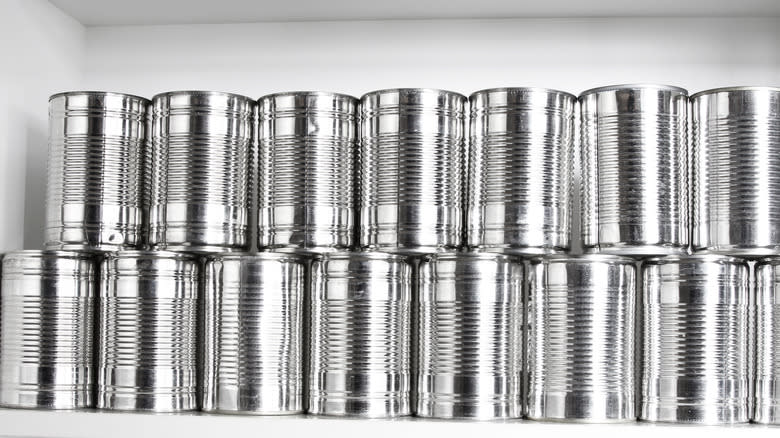
Ah, canned foods: The meal-saver that can make any dish taste "Mmm, Mmm, Good!" (as the old Campbell's jingle goes). Canned foods are durable, portable, and mostly stackable -- and when time is short and convenience is a necessity? Any chef can simply grab a tin from the cupboard, wind it open with a can opener, then pour, heat, and serve.
Now, before you head out to buy cases of canned vegetables to take up any empty pantry space, consider there's more to canned goods than meets the eye. More to the point, the cans themselves require a little TLC over time to ensure the food within is ready to eat whenever you desire it.
Whether the cans are made of tin or aluminum, have a temperature temperament, or are prone to physical changes over time, there are several steps you may want to take to retain the quality of canned goods -- in regards to both the can itself and its contents. With that in mind, we've gathered some tidbits gleaned from personal experience (and confirmed via online research). Here are 12 tips for properly storing canned goods.
Read more: What Happens If You Accidentally Eat Mold?
Designate A Cool, Dark Environment
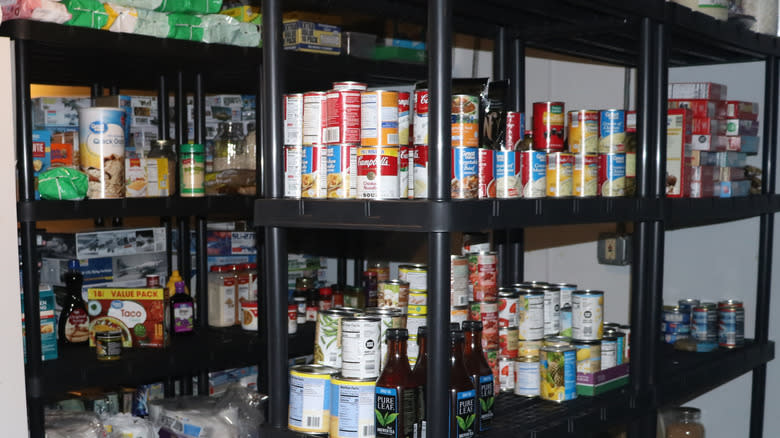
It's a good thing kitchen cupboards and pantries usually come with doors, because canned goods are night owls. When the sun comes up and the day dawns brightly, there's nothing a can likes more than slinking back to the shadows -- and for good reason. Since the sun tends to heat cans -- which can lead to slow spoilage -- it's best to avoid storing canned goods on shelves exposed to bright sunlight.
Prolonged exposure to sunlight can cause your cans' labels and colors to age and fade, as well. While this is mostly aesthetics, it can make your canned goods look a bit vintage. Since this might not be what you want when guests drop by and warily peruse your pantry, it's better to keep your cans out of direct sunlight.
Additionally, canned foods generally prefer an even room temperature between 50 and 70 degrees Fahrenheit. Keep in mind this temperature rule of thumb works both ways, so you may want to reconsider stacking cans in a basement pantry situated next to water pipes prone to freezing. Your cans could repeatedly freeze and thaw in that environment and potentially contaminate the contents, so try finding a different location to place canned goods in the future.
Keep Canned Goods In A Dry Space
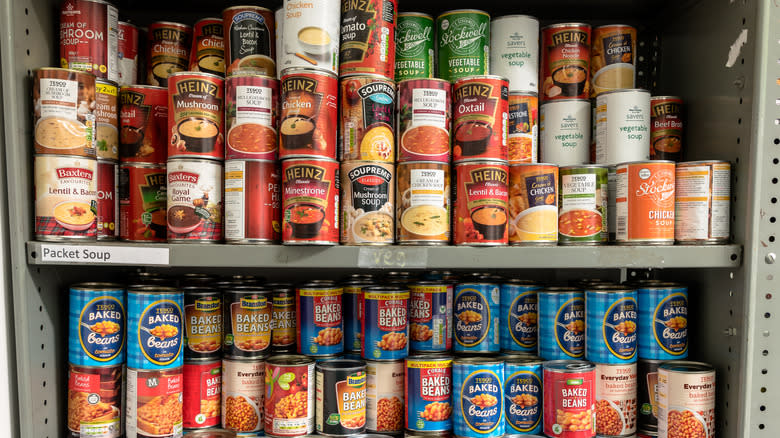
Canned goods are finicky when it comes to water. Yes, canned food is usually packed with various liquids and brine to keep the interior contents moist. However, the exterior surfaces should be kept away from moisture as water can easily interact with the can's metal -- potentially leading to rust and mildew forming. Excess external moisture can even trigger bacterial growth in the food itself, which is why the most important consideration when storing unopened canned goods may be storing them in a dry area.
Now, at times, moisture might be unavoidable. If you live in a humid environment, for instance, or if your basement is the only practical place to store canned food, you might not have the luxury of avoiding all dampness. If you do place cans in these areas, just periodically inspect them to make sure they look okay.
For anyone unconcerned about canned goods spoiling because they believe the excess amount of salt added to canned goods helps preserve the food while keeping dangerous microorganisms from growing? You'd be wise to stop believing this salty canned food myth. The salt is just for flavor, after all, and compromised cans are still apt to add some unwanted green stuff to your canned green veggies.
Allow For Plenty Of Air
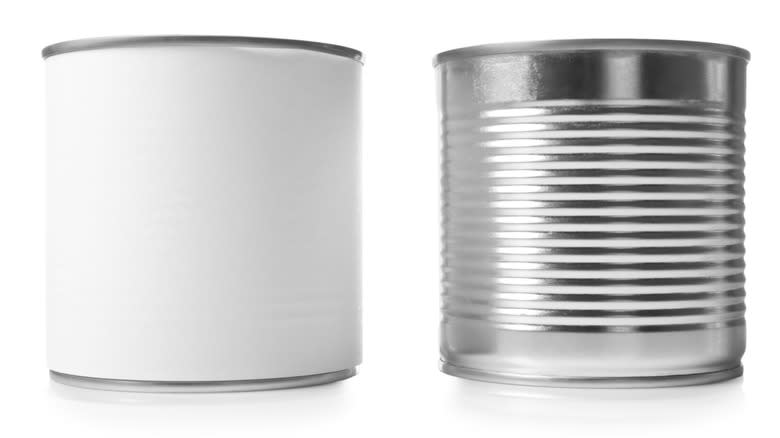
When Andy Warhol painted his famous Campbell's Soup Cans in 1962, he unwittingly created a vital public service announcement. After all, while Warhol left space between his 32 cans to show symmetry and order (while demonstrating the monotony of eating the same lunch every day for decades), his masterpiece had an Easter egg that any food scientist would appreciate: don't cram your cans too closely together.
Now, the reason you'll want to consider giving canned goods room to breathe is related to the prevalence of aluminum usage by modern canneries. Originally, tinplate was used for canned goods, which was fantastic given its durability and resistance to corrosion and mildew. Though some foods are still housed in tin cans, aluminum is both cheaper and easier to produce, leading to it becoming the industry standard over time.
While the reduction in packaging and transport costs is appealing, one drawback to aluminum is its potential to corrode when in contact with other metals. When aluminum is placed next to certain metals, the two may form an electrical charge that typically weakens aluminum. To prevent this risk of aluminum corrosion, make sure the cans keep some distance from each other. It might not look as artfully constructed as a Warhol masterpiece, but at least your food –- and the cans -- will be safe.
Keep Cans In One Place
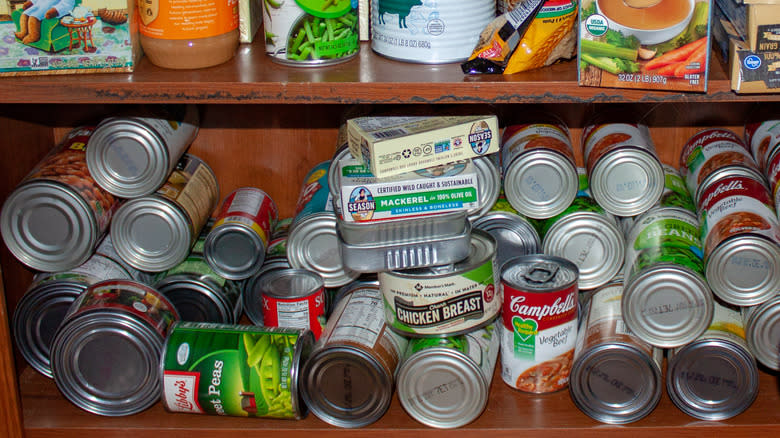
Everything has its place -- particularly in the kitchen. Still, a busy chef may try to save some time after a grocery run by haphazardly throwing newly bought canned foods wherever space presents itself. Bottom cabinets -- like that empty cupboard under the sink -- are popular contenders for temporary storage when your other cabinets are jumbled. One can always come back and clean up later, after all, and a can of Spam won't go bad if it sits under the sink for a couple of days, right?
Unfortunately, out of sight often means out of mind (for good) when it comes to canned foods. In fact, it's wasteful storing canned goods in bottom cabinets because it's incredibly easy to forget about those items once they're been placed below eye level (where we aren't apt to peek while searching for a mysteriously missing can of corn).
You should avoid storing canned goods above the stove for the same reason; it's easy to overlook that area of the kitchen, as well, and the heat from the stove and oven may impact the can and its contents. By keeping your canned goods together (and avoiding certain low or high cabinets), you'll make it easier on yourself by knowing what's on hand -- and reduce the risk of spoilage in unfriendly environments.
Rotate Your Stock
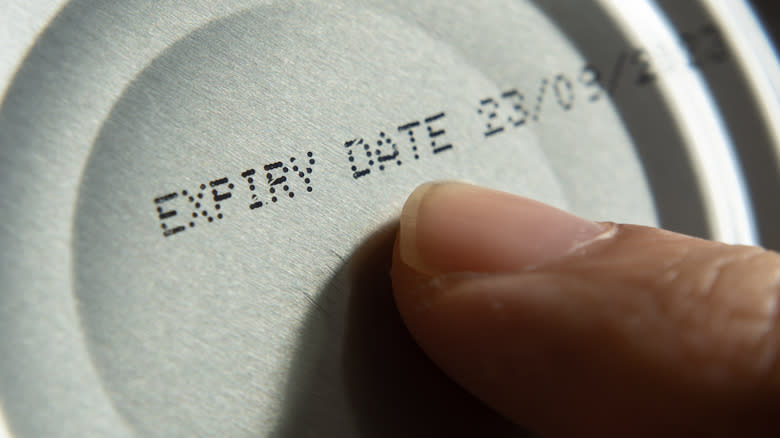
Canned goods are sealed, which makes them handy for long-term storage -- whether it's stockpiling your favorite canned beans during a special sale or prepping for the inevitable day the zombies rise and attack (we're kidding). Now, just because canned foods are sealed doesn't mean they'll last forever. But they'll last a long time -- and may stay safe and edible long past certain dates printed on the can.
You can still use certain canned foods after the best-by date, for example, as that date mainly indicates when a canned food item is at its peak freshness. A best-by date also alerts retailers to which cans are the oldest, providing a handy way for grocery stores to rotate out older stock that may not appeal to customers.
Of course, while canned food doesn't necessarily expire the day after a best-by date passes -- meaning you won't expire, either -- older cans are undoubtedly prone to losing a bit of flavor and taste the longer they remain in storage. To ensure you get the most out of your canned foods, then (flavor-wise), rotate your pantry to eat the older cans first.
Organize Your Cans By Type
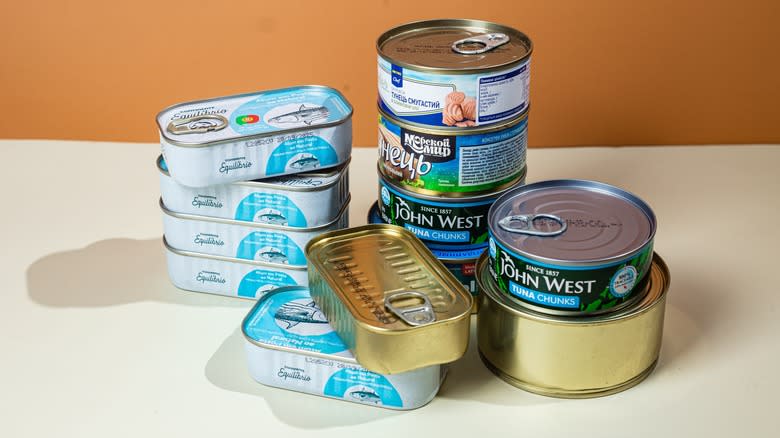
Lyricist Greg Brown's country ditty "Canned Goods" told listeners that "peaches on the shelf" and "potatoes in the bin" offer a taste of the summertime. While this might make it seem fun to group food by season, well ... you'll probably end up tearing your hair out come winter when you're trying to remember if the canned meats stocked in your pantry were separated by month.
Rather than stressing about whether you grouped the ham with Easter goodies or the Christmas festivities, skip using a clever theme in your pantry altogether, and stick to basic organization by food type. Grouping canned goods by the type of food inside will drastically simplify the ingredient-gathering process when canned foods are required by a recipe.
Organizing by food type is also easier than alphabetizing canned goods by brand name or main ingredient. When grouping varieties of canned seafood, for instance, you can simply store them all together (rather than worrying about where to place that Chicken of the Sea can).
Make Sure All Your Labels Are Facing Front
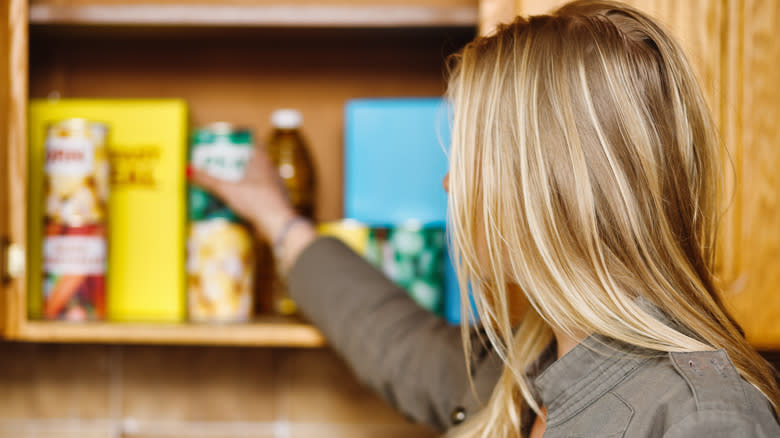
We've all been there: When time is short (along with your temper) after a busy day shopping, you likely just want to toss those canned goods on the shelf once you're home. The most important thing is that they're in there, after all ... though that's only true up to a point.
Consider why supermarkets turn canned goods so the label faces the customer. Not only does this make for a neat display with easily recognizable product names, but it allows for a quick spot-check of what a store has and how long it's been there -- something that also applies to canned goods with forward-facing labels at home. After all, if you see a canned good in your pantry advertising a contest that ended in January 2020, you'll know that can's been there for quite some time.
Another advantage of turning labels forward is the potential to become more familiar with the foods you eat. The label can reveal some telltale signs of high-quality canned tuna, for example, including whether it was caught with sustainable, environmentally friendly practices, and if the product in question is dolphin safe.
Use Magazine Holders To Help Organize The Pantry
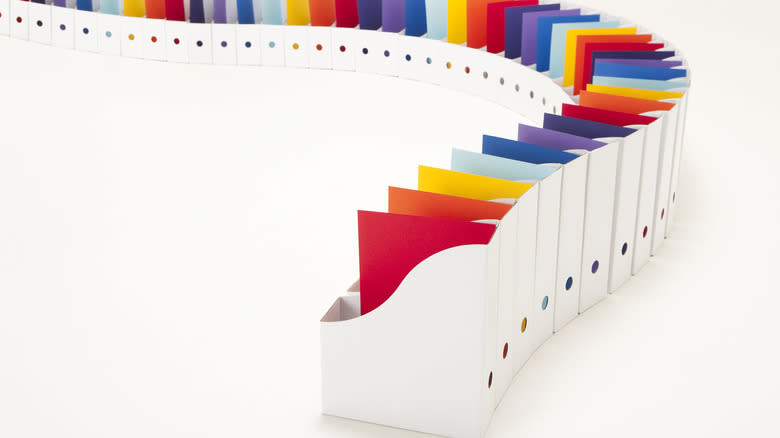
When Old Mother Hubbard went to the cupboard and found it bare, tragedy nearly ensued. Forced to confess to her little dog that she couldn't give him a bone, the good mother ran to the store, then returned to find her dog prank-starving himself in revenge. While the poor widow's pup didn't actually perish, Old Mother Hubbard could've avoided the stress and heartache entirely if she'd had a system in place that alerted her when an item was running low -- something you can accomplish with a simple set of magazine holders.
The simple magazine holder is an unexpectedly great way to store canned goods in the cupboard (for you or Old Mother Hubbard). The holders are wide enough for most standard-sized cans, and the racks are durable enough to keep smaller canned goods from falling between the cracks.
Magazine holders can also be organized by color to categorize your favorite foods. Additionally, if a can is stored on a higher shelf, you can simply pull down an individualized holder rather than blindly groping for an unseen can; and when a rack runs empty, you immediately know it's time to refill. So heed the advice not taken by Old Mother Hubbard, and try using magazine racks to organize canned goods (thus avoiding the famous nursery rhyme character's unfortunate fate).
Expand Your Storage Space
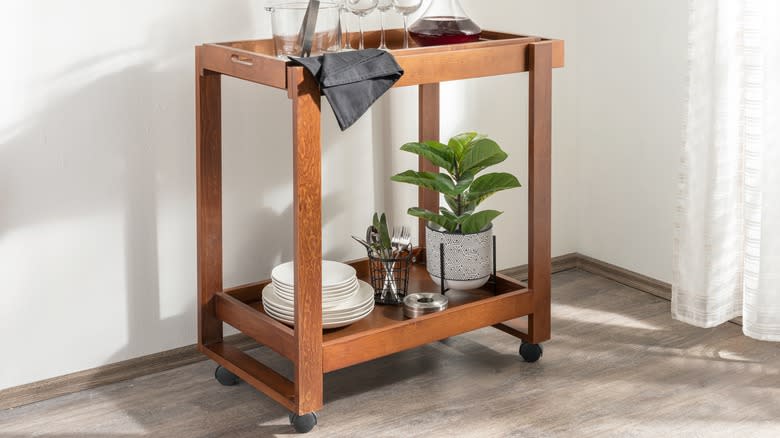
When it comes to time-savvy cooking, it feels like the clock always has us beat. No matter how efficient we are in saving precious moments in our schedules, we never seem to have enough time. Now, it's clear a well-stocked pantry is a great way to make sure you have any ingredients you might need. But when every minute counts, a pantry can be your worst enemy, too.
If sorting through canned goods in the closet leaves you frustrated (even with a well-organized collection), you may want to think outside the pantry -- like a bar cart. A bar cart provides an excellent spot for canned goods, particularly when cans start taking up too much storage space. Think of the cart as a temporary ingredient space, where you can take out the cans you know you'll be using that week -- or even that day -- instead of rummaging around inside a pantry.
A bar cart's mobility provides another plus since you won't need to make repeated trips to the cupboard if the necessary ingredients are already on the cart -- meaning you can concentrate solely on crafting your recipe. Just be sure to use a bar cart that's sturdy enough to hold canned goods and can be secured to avoid any accidents.
Get Rid Of Damaged Cans
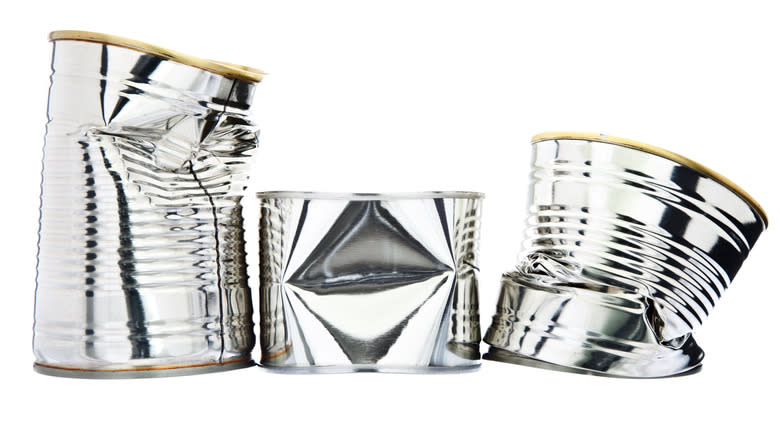
It might be tempting to load up on dented (and steeply discounted) canned goods at the store. But you'll want to think twice before eating from a dented can. Small nicks might be okay, but if the dent is severe enough? The can's integrity may be compromised -- even if it looks intact to the naked eye.
Now, if a small dent happens because a little kitchen helper accidentally drops it, well, there's generally no reason to toss it out. But it's best to use the food fairly quickly rather than just putting it back in the cupboard (after you've mopped up any mess, that is).
Damaged cans can go in the other direction, too, where instead of a dent, a can might end up bulging outward. Rather than a sign the manufacturer packed a free bonus or prize, bulging cans often indicate spoilage. It may be dangerous to eat from a bloated can because the can's shape might have changed as a result of gas released by bacterial microorganisms inside the can. Along those same lines, if your canned food makes a hissing sound when opened, that might be a cause for concern (especially if the hiss is exceptionally loud or food starts to squirt out upon opening).
Don't Store Opened Cans In The Pantry
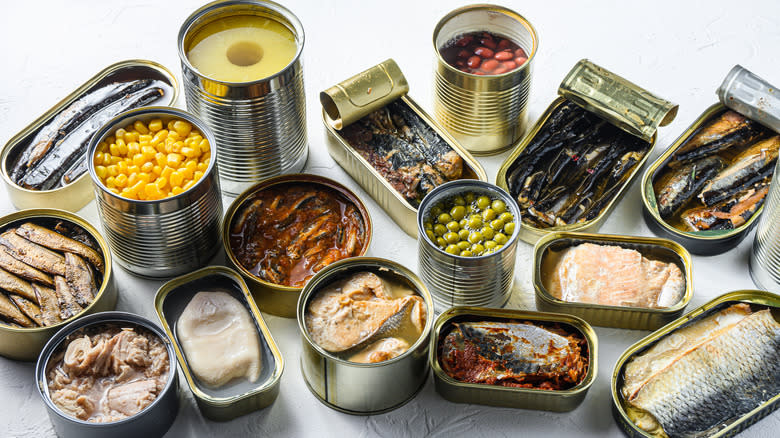
Imagine you have a craving for Spam, and you send someone to the market to obtain a bite-sized serving of canned pork to satiate your desire ... only they return with a canned monstrosity weighing nearly 4 pounds. While you may be tempted to shove the opened container of Spam onto the pantry shelf once you've satisfied your urge, you'd be better served opting to use your leftover Spam right away (or properly storing it).
Quite frankly, it's a bad idea to store leftover canned food in the original can once it's been opened. For one thing, once a sealed can is open, its freshness is lost. Canned food packed in brine or other liquids will start to dry out, which takes out much of the flavor (and is apt to lead to spoilage in the long term).
For canned food that's been opened, it's best to transfer the contents to a sealable container and place it in the fridge -- especially if you don't plan on eating it right away. Like fresh leftovers, the refrigerator can prolong the shelf life of canned goods removed from the can, and keep the formerly-canned contents safe whenever your craving comes back.
Keep An Inventory List
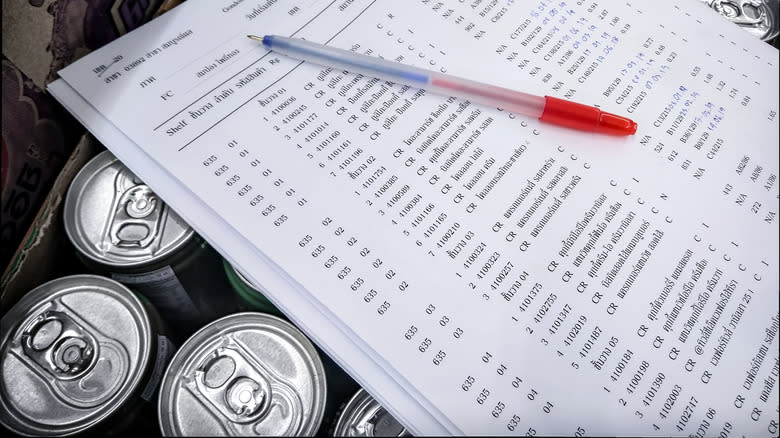
Your pantry might be neat, well-ventilated, and categorized by type, size, and color. But there's one more pantry hack that many home cooks often forget: an inventory list. This simple way to organize your pantry ensures you know exactly what you have rather than trying to remember every can you have in stock or eyeballing it. An inventory can help reduce your food waste by making sure you use canned goods before they reach an actual expiration date and spoil, while saving you time (and potentially money) when writing a shopping list.
Keeping an inventory can help you remember the specific personal preferences of each member of your household, as well (such as Junior's predilection for fresh mushrooms and meats rather than their canned counterparts). The inventory can range from simple tally marks on a chalkboard or dry-erase board, to a sheet of notebook paper that's posted inside your pantry door.
Producing and maintaining an inventory list might seem like an extra and unnecessary step to some. But it's undeniably helpful with keeping your canned goods from taking over the pantry. Plus, if you're the type who loves to whistle while you work, you'll have a ready-made soundtrack while you're bustling about with pen to paper: the "Can-Can" by Jacques Offenbach, of course.
Read the original article on Tasting Table.

